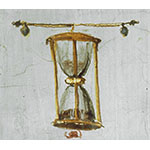Ancient timepieces consisting of two stacked vessels connected by a tiny opening. Models filled with sand or powder are called hourglasses; water clocks are also referred to by the original Greek name clepsydra. The passage of time was measured by the quantity of water or powder that had flowed into the lower vessel, or by the decrease in the level of the substance in the upper vessel. However, the decrease in content led to changes in pressure, and the resulting disturbances undermined the precision of the measurement. The most sophisticated models included a mechanism for continuously filling the upper vessel in order to maintain a constant pressure on the flow.
Related objects








